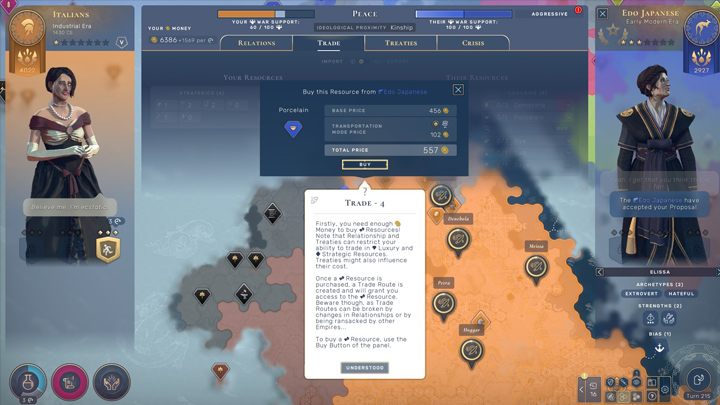Humankind: Luxury resources, trade and monopoly
In this part of the Humankind game guide you will learn more about luxury resources, nadlu and monopoly.
Last update:
On this page of our Humankind guide, you will read about luxury and strategic resources. You will learn how to use them. These are special types of raw materials, the amount of which is limited on the map. To use them you need special technologies and erect special buildings on the map.
Luxury resources
Luxury resources are one of two additional resources. It is not necessary for the development of your empire. However, having these resources greatly facilitates the gameplay and increases the advantage of the development of your cities, the pace of production or acquired technologies. Luxury resources can be traded or monopolized to get a wondrous effect. In addition, if you build a Market District in the area, this city will receive additional funding points.
Every luxury resource is a special field on the map. A place like this must be under the control of the player who has an outpost or a city there. Territories with only an outpost, can have special extractors placed within one round by paying with points of influence. Luxury resources in the territory of the city (whether it is the original region or annexed) can be consumed only after the construction of the Artisans Quarter.
Luxury resources offer two types of bonuses: 4 stability points for each city and the FIMS bonus which it is different for every luxury resource.
There are 20 types of resources in the game, and each of them is divided into 4 categories based on the FIMS type. Each category is divided into 5 different bonuses that are unique to the resources. So, there are 5 luxury resources offering bonuses for food, 5 resources with a bonus for science, etc.
Each resource in a category offers one of the following bonuses:
- 5 resource points for each city.
- 3 units of resources for the city for each district of the administrative center.
- 1 resource point for a specialist in your category in the city.
- 2% of the resources in the production of each city.
- 2 resources in each district corresponding to a given luxury resource category.
For example, a bonus of 1 resource point of a given category for each specialist offers: coffee (food), marble (industry), pearls (funds) and lead (science). Having several resources of the same type adds up, regardless of whether you yourself extract such a resource or buy it from other players. Capturing areas with strategic resources is always a good idea.
Trade
Trade is a way to exchange luxury and strategic resources. This is a good way to gain additional funds, use unavailable resources in your empire, or increase the effects that can be obtained from luxury resources.

The player's empire can exchange resources with any player with whom it has a signed trade agreement. You can't just do that with a player you're fighting an open war with. In the diplomacy window, just select the trade tab and select the raw material you want to buy/sell. You can only trade resources that are already mined. If you have not yet built the extractors, then it's time to do it.
After signing the trade agreement, several things will happen:
- The seller receives a certain amount of funds, and the buyer gets access to the resource.
- When signing a trade agreement, you can choose which way such a resource will be delivered - land, sea or air transport.
- The trade route offers additional fund points for each territory it passes through. Such routes may be looted by enemies or closed when diplomatic relations change.
- Trade routes also help to spread the zone of influence and religion. In addition, they offer a field of view on established trade points (outposts and cities).
- Some infrastructure bonuses offer additional funds for each trade route, as do some emblematic districts.
Trade in luxury and strategic resources does not cause the loss of such resource. The sale and purchase of raw materials does not result in the loss of related bonuses for the owner of the resource. The other party to the trade agreement receives a copy of the resource, but receives all bonuses associated with it.
Wondrous effect
The amount of luxury resources on the map is limited. The number of deposits, that is, fields with a given resource, is set at the beginning of the map generation and does not change until the end of the game. Each luxury resource offers several bonuses, but having half the deposits of a given luxury asset can trigger a wondrous effect and increases the stability bonus for such a resource from 4 to 10 for each deposit controlled. The bonus works for all cities in the player's empire. Having a monopoly on a given resource is very useful, especially later on.
To trigger a wondrous effect, you need two things:
- Holding half of deposits on the map of the resource. Bought resources do not count.
- Developing Patronage and the construction of a special Manufactory building, on an already existing extractor. Once built, you get 50 fame points, and the building itself offers 5 influence points and additional funds for each adjacent market quarter.
Each luxury resource category offers the same bonus for its type: 5% to production, for each unit of a given resource. The more resources you need to trigger a wondrous effect, the greater the benefits for your cities. Moreover, several monopolies of the same category aggregate this effect. This combination can greatly accelerate the expansion and production of your cities.
Example: suppose you have a monopoly on tea, and you have 4 deposits of this resource. This translates into a bonus of 20% for food production in each city (plus 40 stability points). In addition, if the player had a monopoly on, for example, salt (2 deposits) and coffee (6 deposits), the percentage premium to the food produced would increase to 60% (which in total with tea gives an additional 120 stability points).
You are not permitted to copy any image, text or info from this page. This site is not associated with and/or endorsed by the developers and the publishers. All logos and images are copyrighted by their respective owners.
Copyright © 2000 - 2025 Webedia Polska SA for gamepressure.com, unofficial game guides, walkthroughs, secrets, game tips, maps & strategies for top games.
